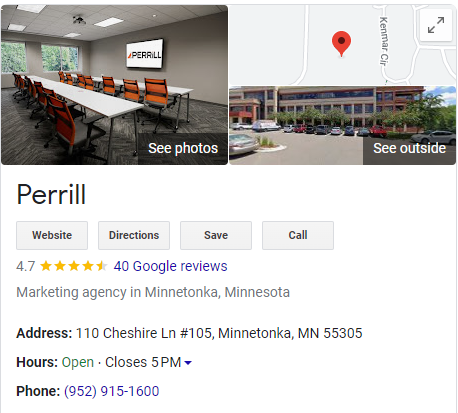
The Benefits of Local SEO: A Practical How-To Guide
If your local business still feels like a well-kept secret, blame the map pin—not the latte art. In a world where “near me” searches and AI snapshots decide where people spend money, relying on word‑of‑mouth alone is a gamble.
Local search is how people find you, whether they are searching via Google, TikTok, Reddit, or Facebook. This is why relying on search engine optimization strategies tailored to local and service area businesses can amplify your local customer reach and bring more traffic to your website—and your front door. Modern local marketing spans online and offline channels and, when done right, drives:
- Brand discovery and recognition
- Search visibility (including AI-generated answers)
- Engagement, conversions, and in-store visits
- Loyalty, repeat purchases, and referrals
Strengthen your brand with a comprehensive local SEO strategy that will help users discover your business no matter how they're searching.
What is local SEO and why does it matter?
Local SEO tells search engines and AI answer engines exactly who you serve and where you operate. By weaving city names, neighborhood landmarks, and service-area signals into your online footprint, you attract nearby clicks, local search visibility, and ready-to-buy foot traffic while cementing brand recognition on your own turf.
Adding city names, neighborhood cues, and service-area signals helps you rank in local search results. These elements tell search engines exactly who you serve and where you operate, so you can:
- Drive nearby traffic (digital and foot)
- Build brand awareness exactly where you operate
- Win high-intent queries like “coffee near me” or “HVAC repair in St. Paul”
If you need more local eyeballs on your storefront, local business, or service-area business, then using local SEO strategies will help you gain ground in an AI-shifting, map-heavy search landscape where local pack results and AI Overviews win the most customers, and 24/7 access to qualified expertise wins the day.
What types of businesses should prioritize local SEO?
The short answer: If revenue depends on people in your city or region finding you first, local SEO belongs at the top of your marketing checklist.
Local SEO delivers outsized returns for any company whose customers come from a defined geography. Brick-and-mortar businesses—coffee shops, boutiques, dental clinics—need it to surface in “near me” searches and steer foot traffic straight to the door.
Service-area companies such as landscapers, HVAC contractors, or plumbers win as well, because an optimized profile puts them in front of homeowners within their radius, even without a storefront.
How can “local SEO” tactics and strategies help with GEO, AEO, and LLM visibility for my business?
When it comes to LLMs, answer engines, Google's AI Mode, and Google’s AI Overviews, visibility, consistency, and readability are key. Tactics once considered exclusive to local businesses now help all businesses stand out in AI-driven results. That’s because LLMs prioritize clear, structured, and location-specific information they can easily understand and trust.
For example, when your business uses the same name, address, phone number (NAP), and URLs across your website, directories, and social platforms, it signals credibility and reliability. LLMs are scanning for accurate, helpful answers—and the more consistent you are about who you are, where you are, and how to reach you, the more likely you are to surface in AI-generated responses.
SEO tools like Google Business Profile, schema markup, and Bing Webmaster Tools can also help your business with generative engine optimization (GEO) and AI visibility. These tools provide signals to LLMs that help them identify what your business does, where it operates, and who it serves.
Localized content and FAQs give LLMs the context they need to surface your business in response to nearby or intent-driven queries. Reviews and citations enhance credibility, which LLMs often factor into the answers they generate.
By using these strategies, businesses improve their chances of being recommended or mentioned in AI-generated responses. Local SEO tactics and strategies serve as a bridge between your business and the AI systems shaping how people discover information today.
What are local SEO tools and strategies that I can use for my business?
Stop guessing and start ranking! The ten steps below distill years of local SEO know‑how into high‑impact actions. Work through them systematically or jump straight to your biggest gap. Then, watch your local visibility climb.
1. Claim & optimize your Google Business Profile (GBP) and other local listings
Think of your Google Business Profile and other local listings as the digital front door to your local business—it’s often the first thing local customers see. Lock in the right primary category, fill every field with rich details and eye-catching photos, and activate the messaging feature so prospects can reach you instantly. Treat your profile as a living feed: post timely offers or updates each week to keep both searchers and Google coming back.

- Choose one primary category and up to nine additional categories.
- Add hours, photos, descriptions, and/or menus.
- Post updates or offers weekly to stay fresh.
- Enable messaging directly from your GBP.
2. Nail NAP consistency across every channel (social media, too!)
Your name, address, and phone number (NAP) business information are the anchor points that tell search engines—and customers—exactly who and where you are. If even one platform shows a different phone number or an outdated suite number, you risk confusing algorithms and missing out on “near me” searches, not to mention irritating customers who found your business through local search.
Use identical NAP details everywhere, then reinforce them with dedicated social profiles for each location, complete with bios and quarterly audits to keep every citation spotless.
- Use the exact same name, business address, and phone number on every platform (GBP, Yelp, Facebook, food ordering platforms, etc.).
- Create individual social profiles for every location you have so that you can post hyper-local offers and rank for your physical location in “near me” searches.
- Add hours, address, and booking links in bios.
- Share GBP posts to social for extra reach.
3. Encourage and reply to reviews
Reviews are your digital word-of-mouth, and they influence both algorithms and human trust faster than any ad campaign. Actively invite satisfied customers to share their experiences, and make sure to reply to reviews using service and city keywords to further amplify local reach. Whether the feedback glows or stings, responding to every review shows you’re engaged, credible, and ready to earn the next five-star mention.
- Ask happy customers for Google/Facebook/Yelp reviews.
- Weave service and city keywords into your replies, as well as specific long-tail keywords that are relevant to that review.
- Respond to every review—positive and negative—to show you’re listening.
4. Build listings and citations
Your Google Business Profile isn’t the only directory that influences local ranking factors—citations across every major map, review, and industry site reinforce your legitimacy. By claiming and optimizing listings on Apple Business Connect, Yelp, TripAdvisor, Bing Places, and niche directories, you send powerful “trust signals” that align your business data everywhere that customers search with local intent. Even local institutions like your chamber of commerce count, so keep each profile spotless and link authoritative listings back to your site for an extra credibility boost.
- Claim profiles on Apple Business Connect, Bing Places, Yelp, and niche directories.
- Submit accurate data to aggregate sites, such as TripAdvisor, Angie's List, etc.
- If you are a chamber of commerce member, make sure your listing is correct. If you have a profile on that website, consider linking it in your about page content.
5. Create service area and locally-focused content
Dedicated service-area pages with embedded Google Maps—and blog posts about local events, sponsorships, and community projects—prove to both search engines and residents that you’re active on their turf.
This local presence builds credibility and trust while boosting your visibility in map-based and generative results.
- Publish a service area page with Google Maps embedded that details the cities or neighborhoods you work with, especially if you will travel to someone's house or business to help them (most common for HVAC, plumbers, appliance repair, etc.).
- Write blog posts covering local events, seasonal tips, community stories, the T-ball league you sponsor, and any day of service activities your business has completed.
- Use natural long-tails like “best fried chicken in St. Paul”, “all day breakfast near me”, and “best children's dentist in the Twin Cities".
6. Ensure mobile-friendliness and speed
Mobile visitors give you about three seconds before they bail, so speed and responsiveness aren’t optional—they’re survival. A site that loads quickly, scales perfectly to any screen, and offers tap-ready buttons, consent banners, and click-to-call links keeps users moving smoothly from search result to conversion. Audit each page on real devices to confirm that every contact form, chatbot, and navigation link performs flawlessly on every screen.
- Ensure your site uses responsive design and loads in under three seconds.
- Make sure button sizes aren't too large or too small.
- Confirm that your cookie consent pop-up is sized so that visitors can accept or decline easily.
- Make sure all of your contact options are working properly.
- Check out how your page renders for mobile search visitors to ensure that visiting your site is a great experience.
7. Optimize contact & location pages
Your contact and location pages are often the final stop before a customer decides to visit, so you’ll need to eliminate every ounce of friction. Make addresses, operating hours, and embedded Google Maps easy to access and add landmark cues like “inside the Oxbow Shopping Center”, “across from Costco on the Green Line” or “across from J street station" for public transportation context cues. The clearer and more specific these details are, the more confidently search engines, answer engines, and real people can route traffic straight to your door.
- List every location with address, hours, and an embedded Google Map.
- Make sure your contact form works, and that all ways of contacting you are working as expected: phone number, email address, and contact form.
- Add specifics related to where your location can be found.
8. Add LocalBusiness schema markup
Search engines rely on structured data to understand and showcase your business details, and LocalBusiness schema is the clearest language you can speak. Adding fields for your name, address, phone, geo-coordinates, hours, and even review snippets turns basic listings into rich results that can boost visibility and click-through rates. Once implemented, run Google’s Rich Results Test to confirm everything’s wired correctly and ready to go. This is a very helpful strategy for multi-location franchises/chains because each location gets its own schema block, improving visibility for individual stores. LocalBusiness schema is also great for surfacing specialties, practitioners, and appointment hours directly within the SERPs, which is especially helpful for healthcare, fitness, beauty, legal, and real estate businesses.
- Include name, address, phone, geo-coordinates, hours, and review data.
- If you’re purely online with no physical presence where you meet customers, and you have no service radius (e-commerce, SaaS, digital products), do not use LocalBusiness schema.
9. Earn local backlinks
Local links are the neighborhood endorsements that tell search engines you’re a real, trusted part of the community. By sponsoring events, collaborating with local bloggers and podcasters, or supporting institutions like the fire department and chamber of commerce, you earn authoritative mentions that boost credibility and rankings. Prioritize backlinks from .edu, .gov, .org, and respected local media outlets—each one signals high-quality relevance right where your customers live. These local signals also help LLMs and GEO-driven platforms understand your business's community presence, increasing the chances you'll be surfaced in AI-generated answers for nearby or intent-based searches.
- Sponsor events, partner with local bloggers, be a guest on community podcasts, join your local chamber of commerce, and donate to the local fire department.
- Aim for .edu, .gov, .org, and reputable local media links.
10. Build a location-based FAQ
A location-focused FAQ turns common customer questions into SEO gold. By answering specifics like “Do you offer same-day HVAC service in St. Paul?” you capture long-tail, high-intent searches while reassuring local prospects. Sprinkle natural “near me” and city phrases throughout, and each Q&A becomes another signal that you’re the trusted choice in their neighborhood.
- Answer real questions: “Do you offer same-day HVAC service in St. Paul?”
- Sprinkle “near me” and city terms naturally.
- Location-based FAQs can go on pages for specific business locations or on a service-area page. If you already have an FAQ page for your business, you can use that, too.
- You can also use your FAQ content on your Google Business Profile!
How often do I need to do local SEO?
Revisit each tactic quarterly as search engines and consumer expectations evolve quickly. Track wins through Google Analytics and Google Search Console for direction taps, phone orders, and revenue tied to “near me” queries so you can double down on what actually moves the needle.
Finally, remember that the best rankings start offline: sponsor events, delight customers, and give your town something to talk about. When you combine digital presence with genuine local engagement, you turn casual searchers into lifelong regulars, and your business stops being a secret, once and for all.
Local SEO isn’t a “set it and forget it” project. It's a set of tools and strategies that keeps placing you in the right place at the right time for local shoppers, local diners, and local customers. By maintaining a spotless Google Business Profile, flawless NAP citations, and a lightning-fast mobile site, you remove every ounce of friction between a searcher and your cash register. Responding to reviews, earning hometown backlinks, and publishing hyper-local content all signal to algorithms and neighbors that you’re woven into the fabric of the local area, that you're here to stay, and that your business can be trusted.
Create a successful local SEO strategy with Perrill
Just like with any SEO strategy, it can take time to rank higher and grow your organic and LLM traffic. These optimizations should improve your local visibility across channels.
If you could use a more fully-formed SEO strategy, we're here to help. We take a unified approach to digital marketing that allows us to build holistic strategies informed by social media, SEO, paid media, content marketing, and more to craft a multi-faceted strategy that makes sense for your unique business needs.
Ready to start showing up in local searches? Our in-house SEO and GEO experts can help your business shine in local listings, LLMs answers, and beyond. Reach out to start strategizing.

Jen Jones
Author
Jen Jones
Categories
Date
Explore with AI
Join Our Newsletter


Why Google Shouldn’t Reveal Its Search Algorithm


8 Signs You Need a Website Redesign


